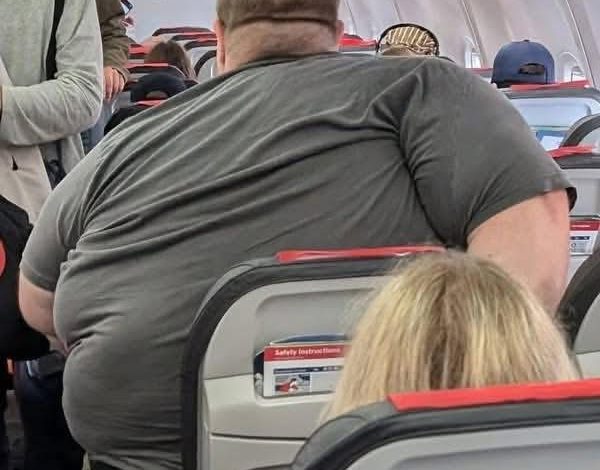
Photo of passenger on flight goes viral, has everyone saying the same thing
A recent photograph has reignited a passionate and nuanced conversation across social media platforms, drawing attention to a topic that has long been a source of both controversy and discomfort: airline seating policies and the experience of plus-sized passengers. The image, which shows a visibly uncomfortable plus-sized traveler struggling to fit within the confines of a standard airline seat, was originally shared by respected consumer rights advocate Christopher Elliott and later reposted by the popular hip-hop group Pretty Ricky. As the image gained traction online, it did more than just capture a moment — it sparked a broader debate about equity, dignity, and the realities of modern air travel.

The conversation surrounding this issue quickly grew beyond a single viral photo. Social media users, travel experts, and body-positive advocates alike began weighing in, offering differing perspectives on what fairness, inclusivity, and practicality should look like when it comes to commercial aviation. While some members of the public argue that passengers who are unable to fit into a single seat should be required to purchase a second seat to ensure their own comfort and that of others, others assert that such policies are inherently discriminatory and fail to take into account the shrinking size of airplane seats — a trend that affects passengers of all body types.
Indeed, seat sizes on commercial aircraft have been steadily decreasing over the years, a fact often attributed to the industry’s efforts to maximize profit by fitting more seats into the same cabin space. What used to be a relatively spacious experience has, for many passengers, become increasingly cramped. And while plus-sized individuals may face unique challenges in these ever-narrower seats, many average-sized and even smaller passengers have also expressed frustration about limited legroom, inadequate elbow space, and the overall discomfort of modern air travel.

At the heart of this renewed discussion is plus-size travel influencer and body-positivity advocate Jaelynn Chaney, who has become a leading voice on issues related to travel accessibility and inclusivity. In response to the viral photo, Chaney spoke out passionately about the need for the airline industry to rethink how it accommodates passengers of different body sizes. She emphasized that no one should be made to feel ashamed of their body or forced to undergo changes to fit into a system that was never designed with their needs in mind.
Instead of placing the burden solely on plus-sized travelers to conform to narrow industry standards, Chaney called for systemic reforms aimed at making air travel more accessible and dignified for everyone. She advocated for the availability of extra seating at no additional cost, more flexible seat configurations, and broader policy changes that would treat all passengers with respect regardless of size or body type. According to Chaney, the focus should not be on changing bodies to fit the seats, but rather on changing the seats — and the policies behind them — to fit the diverse bodies of today’s travelers.
This stance resonated deeply with many in the plus-size community and beyond. In recent years, there has been growing momentum behind movements calling for body-inclusive reforms in various sectors of society, including fashion, entertainment, healthcare, and now — more vocally than ever — the travel industry. Advocates argue that systemic changes are long overdue and that inclusive design should be a fundamental aspect of any service that aims to cater to the general public.
One of the proposals gaining traction is the concept of a “Fat Equality Bill of Rights” — a legislative or policy-based framework designed to ensure that people of all sizes are treated fairly and equitably during air travel. This could include mandates for accessible seating options, clearer customer service protocols, anti-discrimination protections, and perhaps most importantly, a shift in the industry’s broader cultural attitude toward passengers who do not conform to outdated notions of what a “standard” traveler looks like.
However, the conversation has not been without its more extreme and controversial suggestions. In the wake of the photo and ensuing debate, some individuals have suggested that airlines should consider weighing passengers before boarding to ensure weight limits are respected and to aid in the distribution of cabin weight. This proposal has been widely condemned by advocacy groups, passengers, and human rights organizations as invasive, humiliating, and fundamentally disrespectful to travelers’ dignity and privacy. Many have argued that such measures would not only be impractical to implement but would also reinforce harmful stigmas and promote fatphobia — the systemic bias against people with larger bodies.
The suggestion of mandatory weigh-ins before boarding struck a particularly painful chord for many, given the historical mistreatment and marginalization that plus-sized individuals have faced in public spaces. Critics of this idea argue that it shifts the focus away from meaningful reform and toward a punitive approach that fails to address the real issue: the need for inclusive, thoughtfully designed infrastructure that reflects the diversity of the traveling public.
Meanwhile, airline representatives have largely remained quiet in the face of the growing discourse. Some industry experts have pointed out that airlines are often constrained by regulations, financial pressures, and aircraft design limitations that make rapid changes difficult. However, they also acknowledge that customer satisfaction and comfort are crucial to a positive flying experience — and that ignoring the concerns of a large segment of the population could have long-term consequences for brand loyalty and public perception.
As the debate continues to unfold, questions abound: Should airlines be required to redesign aircraft interiors to accommodate a wider range of body types? Should ticket pricing be adjusted to account for different passenger needs? How can the industry balance financial viability with ethical responsibility? And perhaps most importantly, who gets to decide what is “normal” in an age where human diversity is increasingly recognized and celebrated?
For many observers, the answers to these questions lie in embracing empathy and understanding. Rather than framing the conversation as a zero-sum game — where the comfort of one passenger comes at the expense of another — advocates suggest a more collaborative approach. This could involve airlines working directly with passengers, advocacy organizations, and design experts to develop more inclusive policies and products that prioritize both comfort and dignity.
Others stress the importance of continuing to challenge societal norms and narratives that unfairly target plus-sized individuals. They argue that people of all sizes have the right to participate fully in public life — including travel — without facing shame, ridicule, or exclusion. In this view, creating accessible and inclusive travel experiences is not just a matter of customer service, but a reflection of broader values around equality, respect, and human decency.
As with many issues at the intersection of health, economics, and social justice, the path forward is likely to be complex and multi-faceted. It will require thoughtful dialogue, creative problem-solving, and a willingness on the part of airlines and passengers alike to consider perspectives beyond their own. But for now, one thing is clear: the conversation sparked by a single image has opened the door to a much larger reckoning — one that has the potential to reshape the way we think about air travel, accessibility, and the human experience at 30,000 feet.
Whether that leads to immediate policy changes or simply a shift in public consciousness, the impact of this debate is already being felt. It serves as a powerful reminder that every traveler deserves to be seen, heard, and accommodated — not just as a ticket number or a seat assignment, but as a whole person worthy of dignity and inclusion.





